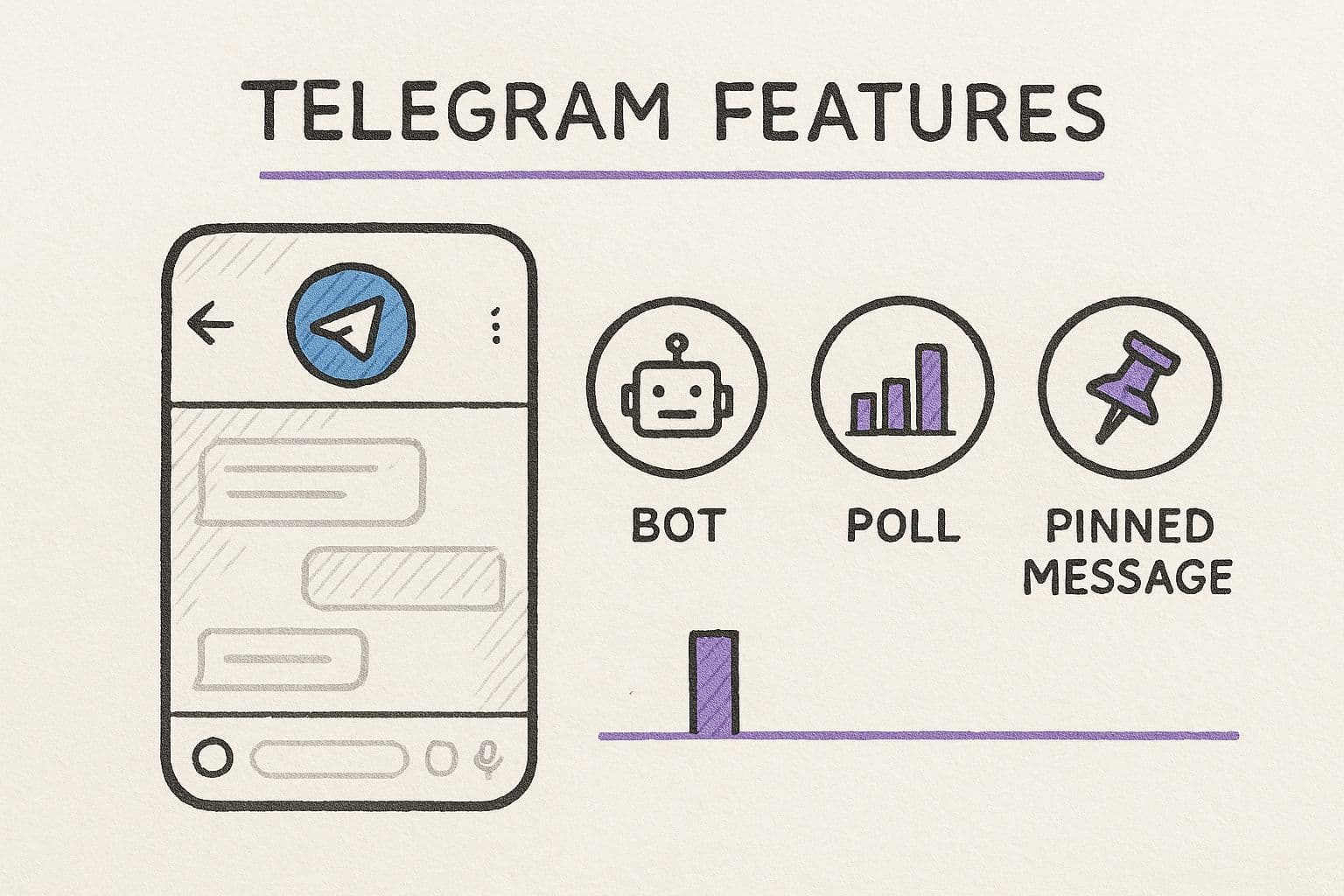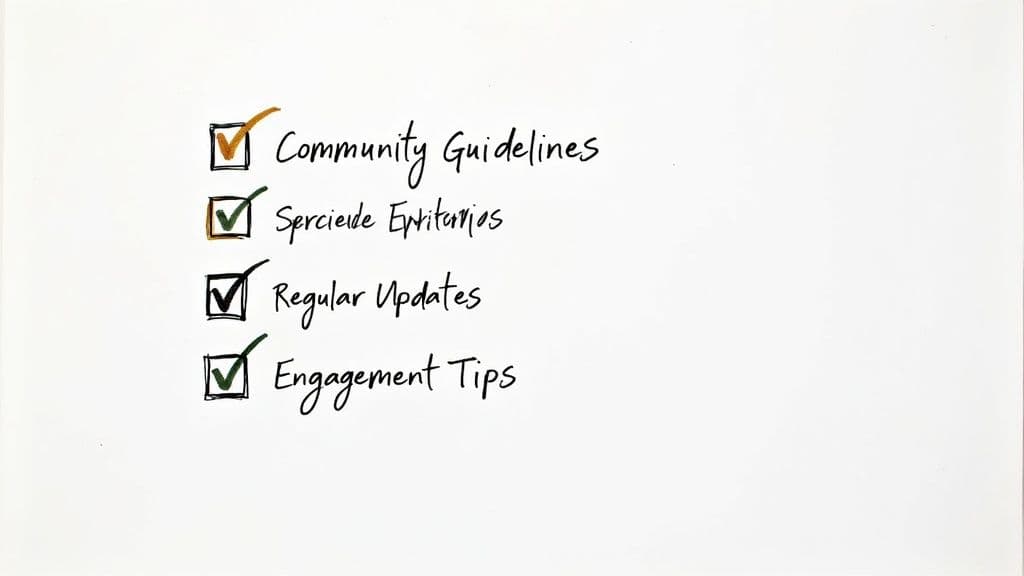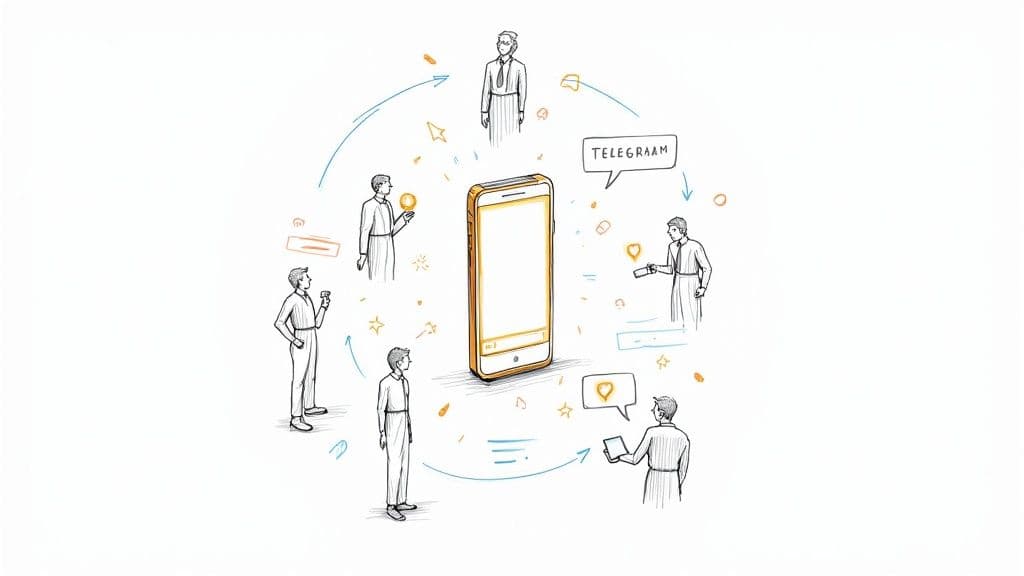Understanding What Makes Telegram Communities Actually Work
To get Telegram community management right, you first need to understand what makes the platform so different from everything else. It’s not just another messaging app; it’s a specific ecosystem built on privacy, powerful features, and a unique user mindset. Getting this wrong is why so many communities end up feeling like digital ghost towns. The secret isn't just posting content; it’s about creating a genuine sense of belonging and purpose.
The most successful communities we've seen all have one thing in common: they lean into what Telegram does best. Unlike other platforms, Telegram offers a distinct mix of public broadcast power through Channels and intimate, feature-rich private conversations in Groups. This duality is a core strength you can build on. For instance, a fitness coach could use a Channel for one-way workout announcements and a private, members-only Group for Q&As, support, and discussion. This creates layers of value that encourage deeper connection.
The Psychology of a Thriving Telegram Group
A massive part of Telegram's appeal is the feeling of exclusivity and security. While its standard cloud chats aren't end-to-end encrypted by default, the platform has built a powerful brand around privacy. Users feel they are in a more controlled, less commercially invasive space. Smart community managers use this to their advantage. They create safe environments where members feel comfortable sharing, knowing the chat isn't being scraped and sold to advertisers. This trust is the foundation of any healthy community.
On top of that, the user base is incredibly dedicated. In the UK alone, Telegram is expected to have nearly 6 million users by 2025, with people spending an average of 4 hours and 25 minutes on the app every single day. That level of screen time is a huge opportunity if you can earn their attention. You can find more details about the growing UK Telegram user base and their habits on Resourcera.
Beyond the Basics: Features That Drive Connection
Beyond choosing between a group or a channel, it’s the smaller, more granular features that truly spark interaction. The best managers use these tools not as gimmicks, but as instruments for starting conversations and building a real community.
- Polls and Quizzes: These are more than just a bit of fun. They’re great for gathering feedback, making members feel their opinion matters, and encouraging low-effort participation that can lead to bigger conversations.
- Voice and Video Messages: A short, personal voice note from you can feel far more authentic than a block of text. It helps build a much stronger, more personal connection with your members.
- Powerful Admin Bots: Automation isn't about being lazy; it's about being smart. Using bots to welcome new members or filter out spam frees you up to focus on real human interactions. If you're interested in the monetisation side, we've explored how to use these features in our guide on using Telegram for business.
Creating Your Community Foundation Without The Common Mistakes
Getting your community’s foundation right is the most critical part of effective Telegram community management. It’s the groundwork that determines whether your group becomes a vibrant hub or a quiet, forgotten corner of the internet. So many new managers jump straight to inviting members, but the real work begins with a few key decisions you make before anyone even joins. This isn't just about picking a catchy name; it's about building an experience from the ground up.
The first hurdle, and a common place to trip, is choosing the right format for your community. Will you run a one-to-many Channel for announcements, or a many-to-many Group for vibrant discussions? A channel is ideal for broadcasting your expertise—think daily trading signals or a weekly fitness tip. On the other hand, a group is where real community happens. Members can chat with each other, ask questions, and build genuine connections. Often, a hybrid approach works best: a public channel to cast a wide net and attract interest, paired with a private, often paid, group for your most dedicated followers.
To help you decide, let's break down the key differences between Telegram Groups and Channels. This table will clarify which format is the best fit for your specific goals.
Telegram Groups vs Channels: Which Format Suits Your Community
| Feature | Groups | Channels | Best For |
|---|---|---|---|
| Member Limit | Up to 200,000 members | Unlimited subscribers | Channels are built for massive, broadcast-style audiences. |
| Communication | Many-to-many (all members can post by default) | One-to-many (only admins can post) | Groups are for discussion and interaction. Channels are for announcements and content delivery. |
| Privacy | Can be public or private | Can be public or private | Both formats offer control, but the choice depends on whether you want a free-for-all or a curated feed. |
| Message History | New members can see the entire chat history | New subscribers see all previous posts | Both are great for onboarding, as new joiners can catch up on past value immediately. |
| Admin Controls | Granular permissions (who can send media, add users, etc.) | Admins can post, delete messages, and manage subscribers | Groups offer more fine-tuned control over member behaviour, which is crucial for managing large, active communities. |
| Use Case | Community discussions, support hubs, masterminds, networking | News feeds, announcement hubs, content delivery, personal blogs | Choose a Group for building community. Choose a Channel for building an audience. |
Ultimately, a Channel is your megaphone, and a Group is your living room. A common and effective strategy is using a Channel to broadcast high-value content that funnels interested subscribers into a more exclusive, paid Group where the real community interaction takes place.
Crafting a Compelling Welcome and Clear Rules
Think of your community description and pinned message as your digital shop window. Don't just state what the group is about; sell the value of being a member. What problem are you solving? What unique insights will they gain? "A group for UK property investors" is okay, but it's bland. A much better description is: "Connect with fellow UK property investors, get exclusive access to off-market deal analyses, and join our monthly expert Q&As to navigate the market." See the difference? One is a label; the other is a promise.
Equally important are your rules and welcome message. Clear, simple guidelines set the tone from day one and will save you countless moderation headaches down the line. Avoid a long, negative list of "don'ts." Instead, frame your rules positively to encourage the right kind of behaviour:
- Keep discussions constructive and respectful.
- Share your wins and support others.
- No unsolicited promotions or links.
This approach fosters a collaborative atmosphere rather than a restrictive one.

71a2d6a7-ca05-4484-9ca7-363dbf35d382.jpg
As the infographic highlights, features like bots, polls, and pinned messages are your best friends for creating structure. By automating welcome messages with a bot, gauging member interest with polls, and keeping the rules front-and-centre with a pinned message, you build an organised and engaging environment right from the start.
Privacy and Technical Set-Up
Finally, let's touch on the technical side of things. While Telegram markets itself heavily on security, it's crucial to understand that standard group chats are not end-to-end encrypted by default. This means conversations are encrypted between your device and the server, but not between users themselves. For most public or hobby groups, this isn't a major concern, but it's a detail worth knowing. True end-to-end encryption on Telegram is reserved for its "Secret Chat" feature, which only works for one-on-one conversations.
The real privacy win for community managers comes from controlling member permissions. From the get-go, you should decide who can add new members, change the group info, or pin messages. Locking these permissions down early prevents chaos as your community grows. Nailing these foundational elements—the right format, compelling messaging, clear rules, and proper technical settings—is what separates a community built to last from one that quickly fizzles out.
Growing Your Community In A Saturated Market

1cda02ec-d00f-48c7-8c66-a7b9207ab76c.jpg
So you've built your Telegram group and set everything up. Now for the hard part: getting the right people to actually join. In a world where everyone has a channel, just existing isn't a growth strategy. Real Telegram community management means you have to be clever and proactive. The goal isn't to be the loudest voice, but the most relevant one in the places where your ideal members already hang out.
Let's face it, Telegram is huge. The platform went from 35 million users in 2014 to a whopping 800 million by mid-2023. That's an increase of over 2,185%. This explosive growth has made the space incredibly competitive, especially for UK community managers. If you want to dig deeper into these numbers, you can find more Telegram user statistics on Social Capital Markets. This massive user base is a double-edged sword: your people are out there, but you need smart tactics to reach them.
Finding and Partnering for Growth
Your first move should be to find other communities that complement yours, but don't directly compete. For example, if you run a group for UK-based freelance writers, linking up with a channel for graphic designers or web developers is a no-brainer. You're both talking to the same kind of audience but offering different value.
Once you find a few good fits, reach out to their admins with a clear proposal that benefits both of you. Don't just ask for a shoutout; offer something in return.
- Cross-Promotion: This is the classic "shoutout for shoutout." You agree to promote their channel in a pinned message for a week, and they do the same for yours. It's simple, effective, and costs nothing.
- Joint Events: Why not host a shared Q&A session or a mini-webinar inside one of your groups? This introduces both communities to fresh expertise and creates a ton of value.
- Content Swaps: Offer to write a high-value piece of content for their channel (like a guide or a checklist) if they do the same for you. It's a great way to showcase your knowledge to a new, relevant audience.
Making It Easy to Join and Share
You need to make joining your group as frictionless as possible. The easier it is for someone to get in, the more likely they are to do it. One of the simplest ways to do this is with a QR code. You can easily generate a QR code for your Telegram group and stick it on your website, in your email signature, or even on flyers at industry events.
Beyond that, think about turning your existing members into your best promoters. A built-in referral system can be a game-changer. Encourage people to share by creating incredibly valuable content that they'll want to pass on—think exclusive reports, insightful infographics, or handy checklists. We cover more ideas like this in our guide on membership growth strategies that can be easily adapted for Telegram. The aim is to create something so good that members can't help but share it with their own networks, driving organic, high-quality growth.
Content Strategies That Actually Generate Engagement
A buzzing Telegram community doesn't just happen; it's built on active participation, not passive scrolling. Your goal with Telegram community management should be to light a fire under your members, making them feel like they're part of the conversation, not just watching from the sidelines. This means ditching the boring announcements and creating content that begs for a reply. The secret is a balanced content plan that blends education, a bit of fun, and real human connection.
To keep your posts hitting the mark without burning yourself out, you need to master your content creation workflow and think ahead. A predictable schedule keeps the momentum going. Instead of posting whenever you feel like it, create recurring 'shows' your members can look forward to. For instance, you could run a "Weekly Wins Wednesday" for members to share their progress or a "Tool-Tip Tuesday" with a quick, valuable piece of advice. This kind of consistency is what builds a loyal following.
Formats That Spark Interaction
On Telegram, how you say something is just as crucial as what you say. Certain post formats are just naturally better at getting a reaction because they make it ridiculously easy for people to join in. Think about it: tapping a poll option takes way less effort than crafting a long, thoughtful comment. Your job is to lower the barrier to entry so much that engaging becomes a reflex.
Here are a few formats that are pure gold on Telegram:
- Strategic Polls: Don't just ask lazy questions like, "What content do you want?" Get specific. A poll that asks, "What's your biggest marketing challenge this week: A) Finding leads or B) Creating content?" not only starts a conversation but also gives you priceless intel on your members' pain points.
- Voice and Video Messages: A quick, personal voice note or a behind-the-scenes video can work wonders. It feels raw and authentic compared to polished text, helping to put a human face to your community and build genuine trust with your audience.
- User-Generated Content (UGC) Prompts: Actively pull your members into the spotlight. You could kick off a monthly challenge or simply ask everyone to post a picture related to your community's niche. When you highlight and celebrate these contributions, you make members feel seen and valued. This transforms them from passive followers into co-creators of your community's culture.
Smart Moderation That Builds Trust Instead Of Fear

embed
Moderation is the invisible force that makes a community feel safe and vibrant, not toxic and chaotic. Far too many admins get this wrong. They see Telegram community management as a game of whack-a-mole, dropping the ban hammer at the first sign of trouble. This doesn't build a community; it creates an atmosphere of fear where people are too scared to say anything interesting.
A better approach starts with trust. Your moderation philosophy should be an extension of your community guidelines – the positive, clear rules we talked about earlier. Pinned at the top of your group, they set the standard from day one. When someone inevitably crosses a line, your first move shouldn't be to kick them out. A quick, private message explaining which rule they broke and why it matters is often all it takes. This simple act of diplomacy can turn a potential troublemaker into a respectful member who understands the group's culture.
Developing a Fair Warning System
Consistency is key to fair moderation. A structured warning system removes guesswork and shows you treat everyone the same. Think of it as a clear escalation path. A first-time, minor offence gets a gentle private reminder. A repeat issue might get a polite but public warning in the chat. Only after these steps do you consider a temporary mute or, as a last resort, removal.
This approach does two things. First, it gives members the respect of a chance to correct their behaviour. Second, it demonstrates to everyone else that you're a thoughtful admin, not a trigger-happy tyrant. This builds incredible loyalty, especially in communities where healthy debate is encouraged. You're showing that you value conversation, even the difficult kind.
To keep things organised, here's a look at some essential tools you can use to manage your community effectively.
| Tool Type | Function | Automation Level | Best Use Case |
|---|---|---|---|
| Built-in Permissions | Control what new members can do (e.g., send media, links). | Manual Setup | Setting the baseline for new joiners to prevent immediate spam. |
| Warning Bots (e.g., Rose) | Track warnings, mutes, and bans per user. | Semi-Automated | Implementing a structured, tiered warning system for rule-breakers. |
| Anti-Spam Bots | Automatically delete messages with blacklisted words or links. | Fully Automated | Fighting off common spam attacks and keeping the chat clean 24/7. |
| Admin Team | Human moderators who handle nuanced conflicts. | Manual | Resolving complex interpersonal disputes that require human judgment. |
This table shows how a blend of built-in features and specialised bots can create a robust moderation framework. By combining automated tools for routine tasks with human oversight for complex issues, you build a system that is both efficient and fair.
Advanced Moderation and Automation
Let's be realistic: as your community grows past a few hundred members, you can't manually moderate everything. It's just not possible. This is where you need to bring in the bots. Good moderation bots are like extra sets of hands, working around the clock.
You can set them up to handle the low-level grind:
- Automatically deleting spam links the moment they're posted.
- Filtering out a blacklist of offensive or banned words.
- Even managing the first couple of steps in your warning system.
For example, a bot can issue an automated "Warning 1 of 3" to a user who breaks a clear rule, freeing you up to deal with more nuanced situations. When you start exploring advanced tools, you might even consider options like using ChatGPT for groups, which can help manage conversations and keep engagement flowing. By automating the grunt work, you can focus your energy on the human side of community building—the part that builds real trust and makes people want to stick around.
Turning Your Community Into Sustainable Income

0541b97a-2e34-47f8-b979-f2b3cbf3e193.jpg
Alright, your community is buzzing. People are chatting, sharing, and engaging. What's next? It's time to think about turning that energy into a proper income stream. This is the part where many creators get nervous, thinking that asking for money will scare everyone away.
But monetisation doesn't have to feel sleazy. When you do it right, it’s about delivering so much extra value that your members are genuinely happy to pay for it. The key to profitable Telegram community management is to offer something that lines up perfectly with what your members already want and need.
The most popular way to do this is with premium membership tiers. This doesn't mean you just slap a price tag on your existing group and call it a day. A much smarter approach is to keep your free channel or group as a brilliant, value-packed starting point. Then, you offer a paid, private group for your most committed followers. This is where you bring out the good stuff: advanced tutorials, exclusive Q&A sessions, early content drops, or even personalised feedback. People are paying for closer access to you and a higher level of insight.
Building Your Monetisation Model
To pull this off, your offer needs to be incredibly clear. What exactly does a paying member get that they can't find in the free group? Don't be vague. For instance, a stock trading community could share general market thoughts for free but keep its detailed, real-time trade alerts for subscribers. A fitness community might post free workout tips publicly but offer personalised meal plans and one-on-one check-ins in its premium space.
In the past, setting this up was a technical headache. Now, platforms like MyMembers integrate directly with Telegram and Stripe, handling the payments and access for you. This frees you up to create amazing premium content instead of messing around with spreadsheets and manually kicking out people whose subscriptions have lapsed. You can create a simple landing page for sign-ups, and the system automatically invites new paying members to your private group.
Beyond subscriptions, there are other ways to earn that can work alongside your community’s main purpose:
- Affiliate Partnerships: Are your members always asking for recommendations? Team up with those brands. You can earn a commission by promoting products you actually use and stand behind. This feels authentic and genuinely helps your members.
- Sponsored Content: You could work with a relevant brand to sponsor a high-value piece of content, like a special webinar or a detailed guide. The crucial thing is to make sure the sponsor is a perfect match for your audience.
In the end, turning your community into a business is all about respecting the trust you’ve worked so hard to build. By offering undeniable value, you can create a reliable income without selling your community's soul. If you're hunting for more ideas, check out our guide on how to make money on Telegram.
Scaling Without Losing The Magic That Made You Special
As your community grows from a cosy group of a hundred to a bustling crowd of thousands, the biggest challenge isn't just managing the noise; it's keeping that special feeling alive. That intimate vibe that attracted your first members can easily get lost in the crowd. True Telegram community management at scale isn't about better tools; it's about shifting your role from a hands-on manager to a skilled leader. This means learning to delegate, create systems, and empower others without losing your personal touch.
Cultivating Community Champions
Let's be real, you can't be everywhere at once. The first step in scaling your community is to find and promote your community champions. These are your most engaged, positive, and helpful members—the ones who already answer questions, welcome newcomers, and uphold the group’s culture. Don't just appreciate them silently; give them power.
- Recognise them publicly: A simple shout-out goes a surprisingly long way.
- Give them a role: Create a "Community Helper" or "Ambassador" title. This isn't just a label; it gives them a sense of ownership and responsibility.
- Create a private chat: Make a small, private group just for your champions. Use it to get their feedback, share plans before anyone else, and make them feel like trusted insiders.
By creating this inner circle, you’re not just getting free help. You’re building a volunteer team that multiplies your presence and reinforces your community’s positive culture from the inside out.
Systems and Segmentation for Growth
When your member count swells, you need systems that help maintain that personal feel. A popular and effective tactic is segmentation. Instead of one giant, chaotic group, think about creating smaller, specialised sub-groups. For instance, a large "UK Entrepreneurs" community could have dedicated sub-groups for "SaaS Founders" or "E-commerce Sellers." This allows for more focused discussions and deeper connections, all while staying under the main community's umbrella.
On the administrative side, using a tool like MyMembers to manage a paid community is a game-changer. It automates payments and access control, freeing you up to focus on high-impact interactions like hosting live Q&As or engaging directly with your new champions. This combination of smart automation and strategic delegation is how you scale your presence without scaling your personal workload, ensuring your community grows without losing the soul that made it great in the first place.
